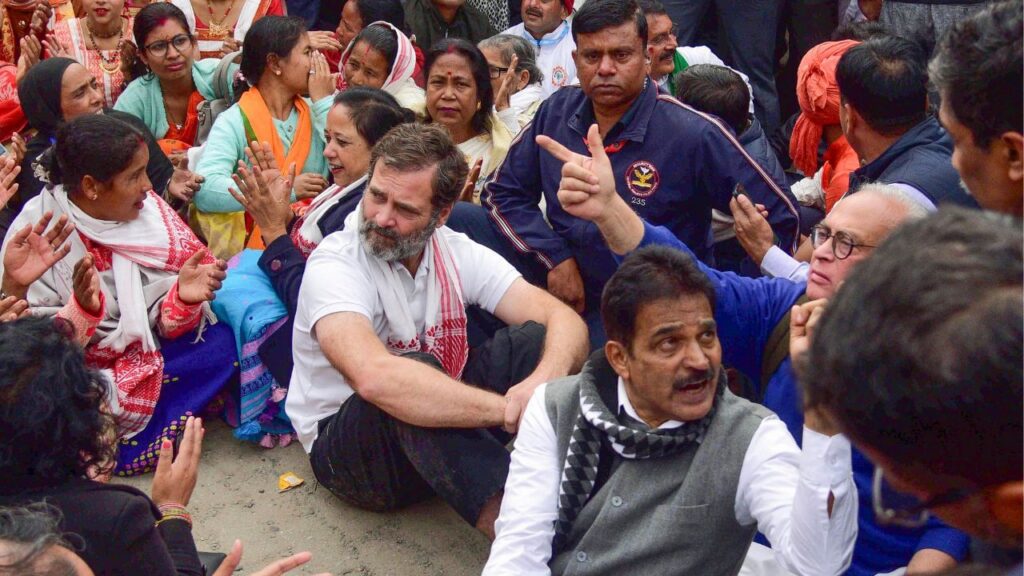News Desk, Kolkata : In a significant turn of events reminiscent of the Ayodhya Ram Temple inauguration, Congress leader Rahul Gandhi embarked on a Bharat Nyay Yatra, reaching Assam. His intended visit to a temple in Nagaon, Assam, faced obstruction, leading him to stage a protest within the temple premises.
The Bharat Nyay Yatra, originating from Manipur, had traversed through the northeastern states, finally arriving in Assam. Initially, there were plans for Rahul Gandhi to visit the birthplace of Shrimanta Shankardev in Batadrava, Nagaon, on January 22. However, things took an unexpected turn when, contrary to the plan, Rahul Gandhi and other Congress leaders were halted 20 kilometers away from the temple in Haiboragao. The police blockade prompted questioning from Congress MPs and MLAs.
Rahul Gandhi, undeterred by the obstruction, chose to sit in protest right outside the temple, expressing his commitment to uphold the principles of law. Despite having permission to enter the temple, he was barred from doing so. Rahul Gandhi addressed the situation, stating, “A crisis of legal discipline will arise if I go, so I may not be able to visit Shankardev’s birthplace. However, others can. I will go when I get the opportunity. Shrimanta Shankardev represents Assam’s ideology. I wanted to visit the temple because he is like my mentor. The temple authorities invited me, but I was not allowed to go. It’s strange that Gaurav Gogoi can go there, but I cannot.”
The narrative unfolds as a tale of political dynamics intertwining with cultural significance. The Bharat Nyay Yatra, originally intended to address issues of justice and equity, now takes on an added layer of symbolism as it encounters obstacles at a revered cultural site.
The incident raises questions about the interplay between politics and religious institutions. While Rahul Gandhi emphasizes the importance of Shrimanta Shankardev in Assam’s cultural ethos, the denial of entry into the temple prompts reflections on the intersection of political figures with sacred spaces.
As the news spreads, contrasting opinions emerge. Some view the incident as a stand for legal principles, applauding Rahul Gandhi’s commitment to abide by the law even at the expense of his visit. On the other hand, critics argue that the situation reflects a broader clash between political agendas and cultural sensitivities.
The story gains momentum as more details unfold. The authorities of the temple extended an invitation to Rahul Gandhi, highlighting the complex dynamics at play. The standoff prompts a deeper exploration into the nuanced relationship between political leaders and religious institutions.
The Bharat Nyay Yatra, initially a journey focused on justice, takes an unexpected turn, becoming a focal point for discussions on the boundaries between politics and culture. The symbolism of Shrimanta Shankardev’s birthplace adds layers to the narrative, turning it into a saga that goes beyond the immediate political context.
In the midst of the unfolding drama, the political climate in Assam becomes a key player. The Congress leader’s determination to visit the temple, despite the hurdles, adds a dramatic flair to the larger political landscape.
As the nation watches, the question of whether politics should intersect with sacred spaces remains unresolved. Rahul Gandhi’s statement, “I wanted to go to Shankardev’s birthplace, but I can’t. It’s strange,” echoes in the minds of observers, sparking discussions on the delicate balance between political rights and cultural sanctity.
In the end, the incident leaves a lasting impact, shaping the ongoing narrative of the Bharat Nyay Yatra. Rahul Gandhi’s protest outside the temple becomes a symbol of a larger struggle, highlighting the complexities inherent in the intersection of politics, law, and culture.
DISCLAIMER
Our news media denounces any form of bias and disapproves of sensationalism. The disseminated news is entirely educational and aimed at social awareness. Our media maintains absolute impartiality, adhering solely to the purpose of education and social consciousness.


